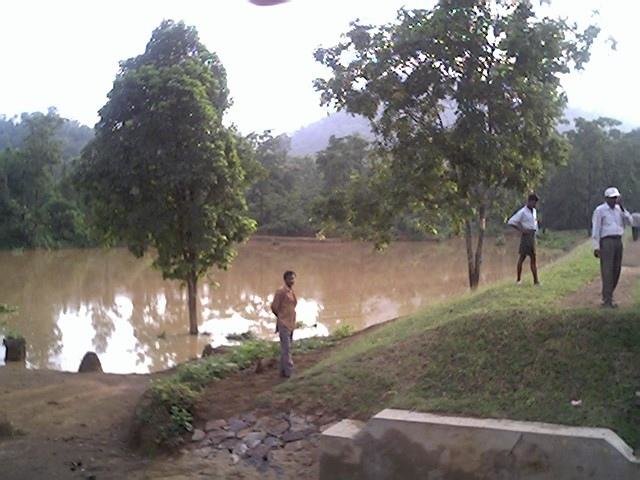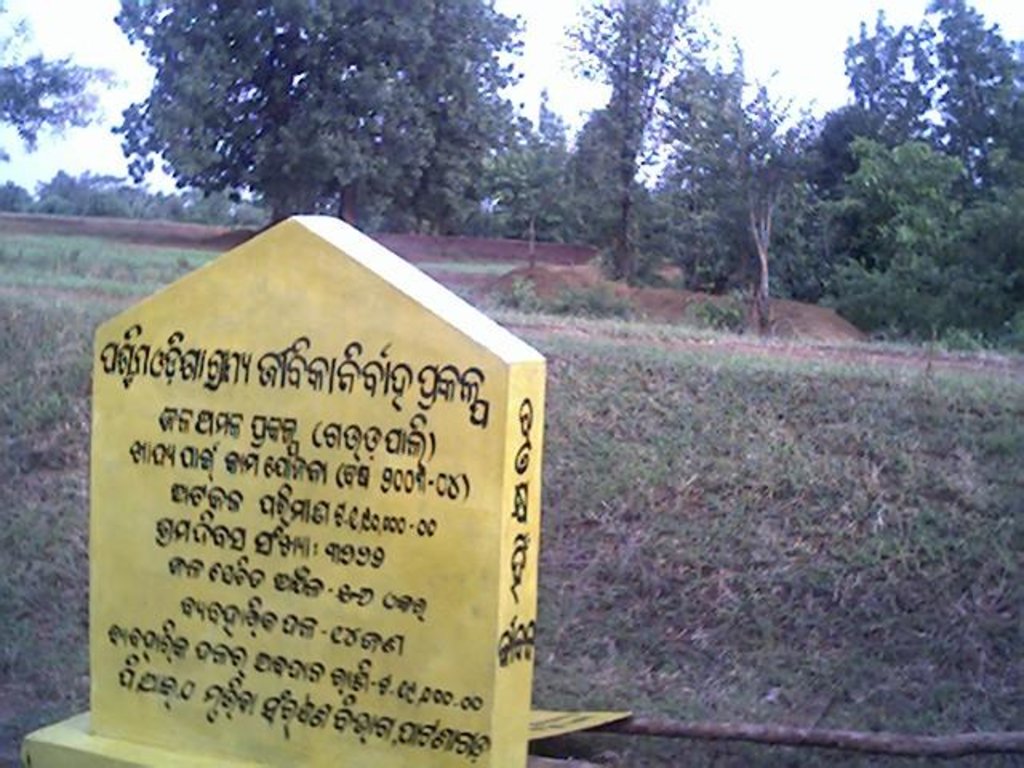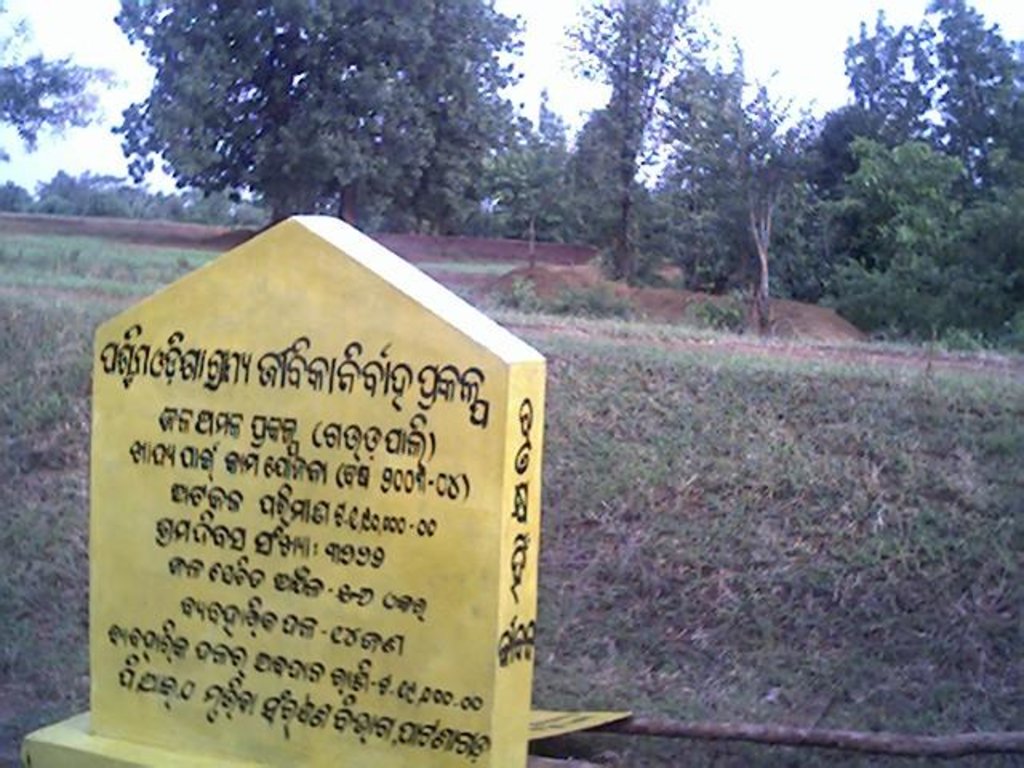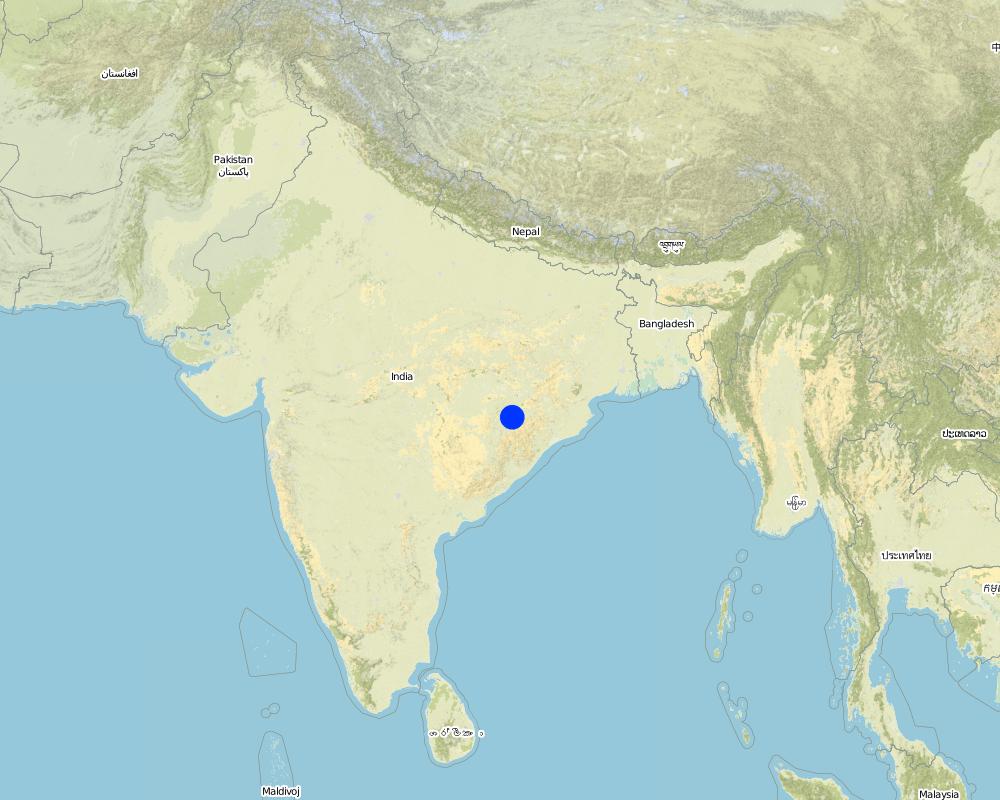Community based sustainable livelihoods [India]
- Creación:
- Actualización:
- Compilador: Unknown User
- Editor: –
- Revisor: Fabian Ottiger
approaches_2371 - India
Visualizar secciones
Expandir todo Colapsar todos1. Información general
1.2 Detalles de contacto de las personas de referencia e instituciones involucradas en la evaluación y la documentación del Enfoque
Persona(s) de referencia clave/s
Especialista MST:
Mohanty Rajib Kumar
India
1.3 Condiciones referidas al uso de datos documentados mediante WOCAT
El compilador y la/s persona(s) de referencia claves aceptan las condiciones acerca del uso de los datos documentados mediante WOCAT :
Sí
1.4 Referencia/s al/los Cuestionario(s) de Tecnologías MST

Dug-out sunken pond cum countour bund [India]
It can be defined as combination of structural & vegetative measures where contour bunds are constructed from the excavated sandy loam soil of cultivated wastelands in semi-arid climatic(?) zone with moderate slope in medium soil depth conditions in order to link with self-subsistance & market oriented production systems from private …
- Compilador: Unknown User
2. Descripción del Enfoque MST
2.1 Breve descripción del Enfoque
Sustainable livelihoods enhanced through people's organisations by linking with other resource organisations prticularly for resource poor.
2.2 Descripción detallada del Enfoque MST
Descripción detallada del Enfoque MST:
Aims / objectives: The name of the project is western orissa rural livelihoods project, supergoal-reduction of poverty in rainfed areas of India, goal- More effective approaches to sustainable rural livelihoods adopted by government agencies & other stakeholders in KBK districts & elsewhere. The overall purpose is sustainable livelihoods, particularly fo the poorest, promoted in 4 districts in replicable ways by 2010 & to reduce poverty by promoting livelihoods initiatives particularly resource poor. Unlike DFID(I)'s earlier rural development projects, WORLP will work within government & follow GOI's watershed guidelines, but extra resources for ' watershed plus' activities: capacity building, minor irrigation, drinking water & livelihood initiatives for the poorest. WORLP is a part of wider effort to help Ministry of Rural Development (MoRD) improve the effectiveness of watershed work nationally;'watershed plus' approach developed in WORLP will be tested for wider replication.
Methods: The project will have basically four types of impact: production impact, employment impact, Poverty alleviation impact & capacity building impact.The project would directly reavh a population of 725,000 people, 80% of whom would be people below poverty line-landless, marginal & small farmers. The Director of the Watershed Mission will answer to an empowered committee chaired by the Chief Secretary; district level will be strenghthened by the appointment of a Project Director-Watershed projects & staff to work alongside the District Rural Development Agencies, funds will be tranferred from the PD-DRDA to the PD-WSP; GoO has appointed full time watershed development teams at block level to support implementation of the KBK plan; WORLP may use these teams, but can also use other government agencies(including Forestry Department in areas with forest land) or NGOs as PIAs. DFID will finance a Project Support Unit at Bhubaneswar, Capacity Building Teams in districts & Livelihood Support Team at block level. The project will fall under state leve Watershed Mission, created to oversee implementation of all MoRDIts main focus is to work with existing strengths & build upon them. In this area 60 to 70% of th population live below official poverty line. Erratic rainfall, limited irrigation, poor capacity of government agencies & restricted opportunities for non-land based activities are major factors. But the key to poverty seems to be the structure of social relations: caste, untouchability, skewed land distribution, land alienation, dependence on money lenders, encroachment on common property resources, gender issues, all of which prevent access by pooe groups to natural resources.
2.3 Fotos del Enfoque
2.5 País/ región/ lugares donde el Enfoque fue aplicado
País:
India
Región/ Estado/ Provincia:
ORISSA
Map
×2.6 Fechas de inicio y conclusión del Enfoque
Indique año del inicio:
2001
Año de conclusión (si el Enfoque ya no se aplica):
2010
2.7 Tipo de Enfoque
- proyecto/ basado en un programa
2.8 Propósitos/ objetivos principales del Enfoque
The Approach focused mainly on SLM with other activities (organising the people in general, & poor (defined by the criteria of villagers), analysis of of problems, constraints, opportunities, threat concerning five capitals like physical, social, natural, finacial & human &)
The objectives of the project approach are mainly three components. Promoting livelihoods improvements, capacity building of primary & secondary stakeholders & encouraging an enabling environment.
The SLM Approach addressed the following problems: Coping strategy against Drought, distressed migration, income in the lean period. Other problems are like employment opportunities, farm & non-farm activities for lan users & landless.
2.9 Condiciones que facilitan o impiden la implementación de la/s Tecnología/s aplicadas bajo el Enfoque
normas y valores sociales/ culturales/ religiosos
- impiden
Unity & transparency
Treatment through the SLM Approach: Awareness, training, exposure visits,Regular rapport building etc.
disponibilidad/ acceso a recursos y servicios financieros
- impiden
Capital for initiatiation of any activities.
Treatment through the SLM Approach: Project fund
entorno institucional
- impiden
People's organisations not strenghthened
Treatment through the SLM Approach: Formation of institution like Self help group, User group, Watershed committee, Community link workers.
marco de trabajo legal (tenencia de tierra, derechos de uso de tierra y agua)
- impiden
Legal provisions like access to Common property resource, rights on assets created etc.
Treatment through the SLM Approach: capacity building on legal provisions.
The existing land ownership, land use rights / water rights moderately hindered the approach implementation operational holdings are highly skewed, appr. 30% of households are landless, & 40-50% are small & marginal farmer, land allienation is wide spread because of indebtedness. Motgaging the land is the outcome due to heavy dependence on private money landers charging unserious rate of interest. Skewed control of land & water. Officially 10% of people own 35% of project area land, inreality appr. 60%
conocimiento de MST, acceso a apoyo técnico
- impiden
Estimates, lay-out & planning
Treatment through the SLM Approach: Regular training to volunteers to create a bare-foot professionals in the village.
otros
- impiden
Community mobilisation
Treatment through the SLM Approach: Common meeting, focus group discussion, adressing household problems.
3. Participación y roles de las partes interesadas involucradas
3.1 Partes interesadas involucradas en el Enfoque y sus roles
- usuarios locales de tierras/ comunidades locales
Wok equally divided between men and women (User's group or Area group mainly men, as most of the land is on the name of men. Self help groups are mainly from women. Although women participated in decision making process & also in the activities, but still men take the important decisions particularly for SWC measures. Perhaps mostly the lands are owned by men. Therfore, participation of men in comparison to women for SWC measures is more. In this connection, villagers opine that women participated benevolently for the first time for planting of seedlings. Some landless goup receives uncultivated wate land in meagre amount 0.5 ha whose land is part of the patch. Nextly representative from th resource-poor & very poor category as per the defined criteria of the villagers are also member of the watershed committee. As the watershed committee mainly responsible for any work because the money flows directly to the watershed committee account.
- gobierno nacional (planificadores, autoridades)
- organización internacional
A project implemnting agency is appointed at the block level
Si varias partes interesadas estuvieron involucradas, indique la agencia principal:
A team of international & national specialist did the study of the four poverty stricken districts of the state. Than they drafted the Project meomrandum which is a broader framework of guidelines stating the robust processes. But it is so flexible in nature that it has every scope for modification as required or desired by the landusers.
3.2 Involucramiento de los usuarios locales de tierras/ comunidades locales en las distintas fases del Enfoque
| Involucramiento de los usuarios locales de tierras/ comunidades locales | Especifique quién se involucró y describa las actividades | |
|---|---|---|
| iniciación/ motivación | pasivo | public meetings; People started participating because root cause of every problem becomes clear to the community. Interaction with all villagers again & again through public contacts |
| planificación | pasivo | rapid/participatory rural appraisal; Planning at time of drafting of micro-plan the land users went for transact of the area along with SWC specialist to sense the problem & alternative solutions. |
| implementación | apoyo externo | Mainly: responsibility for minor steps; partly: casual labour; The implementation of the SWC was done by the User's group with supervision of Watershed committee. The Watershed committee provide cheque to the User's group. |
| monitoreo y evaluación | ninguno | Mainly: measurements/observations; partly: reporting; The monitoring is done at time of measurements/observation by the secretary & watershed committee. The rgular reporting was done by the watershed development team. |
| Research | auto-movilización | on-farm; On-farm demos of the agriculture, integrated nutrient management, intercropping & line sowing etc. |
3.4 La toma de decisiones en la selección de Tecnología(s) MST
Especifique quién decidió la selección de las Tecnología/ Tecnologías a implementarse:
- principalmente usuarios de tierras con el apoyo de especialistas MST
Explique:
Firstly the Project implementing agency & team initiate the discussion in different ways, like training, exposure visits, focused group discussion.The first phase is called rapport building phase for one year, when the livelihood focused micro-plan is prepared. The micro-plan can be modified time to time as per the need & concern of the community.
Decisions on the method of implementing the SLM Technology were made by mainly by land users supported by SLM specialists. In this approach in general & SWC measures in particular, firstly the land user's group raise proposal before the committee. The criteria behind the selection is poor land, poor people, contribution & ridge to valley approach. Than the land users agree to
4. Apoyo técnico, fortalecimiento institucional y gestión del conocimiento
4.1 Construcción de capacidades / capacitación
¿Se proporcionó la capacitación a usuarios de tierras/ otras partes interesadas?
Sí
Especifique quién fue capacitado:
- usuarios de tierras
- SWC specialists (1), extensionists/trainers (2), planners (3)
Forma de capacitación:
- en el contexto de trabajo
- de agricultor a agricultor
- áreas de demostración
- reuniones públicas
- cursos
Temas avanzados:
Reconnainance survey through maps. Transact of the area, Identification of root cause of the problem & alternative solution & demonstration of different items so that the land users get a basket of choices. Another objective of the project to develop volunteers who will get some remuneration & help the land users for future maintainance, estimate, lay-out etc.
4.2 Servicio de asesoría
¿Los usuarios de tierras tienen acceso a un servicio de asesoría?
Sí
Especifique si servicio proporcionado se realizó:
- en los campos de los usuarios de tierras
Describa/ comentarios:
Name of method used for advisory service: Community based sustainable livelihoods.; Key elements: Amalgamation of social & natural resource., Agreement of User's grop, benefit sharing, conflict resolution, prioritisation, etc., Farmer to farmer extension, replication through 'learn by doing & teach by showing methods'; 1) Advisory service was carried out through: government's existing extension system, projects own extension structure and agents; Extension staff: mainly government employees 3) Target groups for extension: land users; Activities: Participatory resource mapping through T
Advisory service is inadequate to ensure the continuation of land conservation activities; It is because it is really to early to conclude about extention. It requires high degree of common sense & commitment. Although extension service is in place but it needs coordination & management which will be hopefully developed by the project within next 3-4 years.
4.3 Fortalecimiento institucional (desarrollo institucional)
¿Se establecieron o fortalecieron instituciones mediante el Enfoque?
- sí, mucho
Especifique el nivel o los niveles en los que se fortalecieron o establecieron las instituciones:
- local
Especifique el tipo de apoyo:
- financiero
- construcción de capacidades/ entrenamiento
- equipo
4.4 Monitoreo y evaluación
¿El monitoreo y la evaluación forman parte del Enfoque?
Sí
Comentarios:
bio-physical aspects were regular monitored through observations
technical aspects were regular monitored through observation
socio-cultural aspects were ad hoc monitored through observations
economic / production aspects were ad hoc monitored through observations
There were many changes in the Approach as a result of monitoring and evaluation: By timely monitoring & evaluation, the stages of the linked institutions are determined & capacity building was determined time to time. Fo example a training to SWC/NRM volunteers, supervision was done after regular interval. Than again after a time period the refresher training was devised as per the receptance of the concerned volunteers.
4.5 Investigación
¿La investigación formó parte del Enfoque?
Sí
Especifique los temas:
- sociología
- economía/ marketing
- tecnología
Proporcione detalles adicionales e indique quién hizo la investigación:
Participatory technology development with proper admixture of social & natural resouce is one of the objective of the project. As the components of technology, social dynamics & economics are interwoven with each other, therefore, research through consultants of national & international repute is a regular part of the project process.
Research was carried out on-farm
5. Financiamiento y apoyo material externo
5.1 Presupuesto anual para el componente MST del Enfoque
Si no se conoce el presupuesto anual preciso, indique el rango:
- < 2,000
Comentarios (ej. fuentes principales de financiamiento/ donantes principales):
Approach costs were met by the following donors: international (DFID): 100.0%
5.2 Apoyo financiero/material proporcionado a los usuarios de tierras
¿Los usuarios de tierras recibieron financiamiento/ apoyo material para implementar la Tecnología/ Tecnologías? :
Sí
5.3 Subsidios para insumos específicos (incluyendo mano de obra)
- equipo
| Especifique qué insumos se subsidiaron | En qué grado | Especifique los subsidios |
|---|---|---|
| herramientas | parcialmente financiado | |
- agrícola
| Especifique qué insumos se subsidiaron | En qué grado | Especifique los subsidios |
|---|---|---|
| Seedlings | totalmente financiado | |
- infraestructura
| Especifique qué insumos se subsidiaron | En qué grado | Especifique los subsidios |
|---|---|---|
| Community infrastructure | totalmente financiado | |
Comentarios:
The unit of the project is a watershed & the project cost is rs. 9,500 per hac, out of which around rs. 3,600/ is for direct SWC measures & rest is for enhancement of livelihood assets & linking to self-sustainable institutions.
5.4 Crédito
¿Se proporcionó crédito bajo el Enfoque para actividades MST?
Sí
Especifique las condiciones (tasa de interés el apoyo, amortización, etc.):
Interest rate charged: 8.0%; repayment conditions: From the project side it one time grant to the watershed committee. But the watershed committee gives loan to groups or individual as per their own norms & condition. As the the project is trying to have a revolving fund in the watershed level for future mainatinance & requirement..
Interest was lower than market rate.
Especifique los destinatarios del crédito :
The person who will avail loan must be in aself help group & must pass through the grading process w
6. Análisis de impacto y comentarios de conclusión
6.1 Impactos del Enfoque
¿El Enfoque ayudó a los usuarios de tierras a implementar y mantener Tecnologías MST?
- No
- Sí, un poco
- Sí, moderadamente
- Sí, mucho
The crop-diversification like change from the minor millets to cash crop & paddy. The land where only one crop season, but now they are taking up two crops, like kharif & pre-Rabi crops etc.
¿El Enfoque mejoró cuestiones de tenencia de tierra/ derechos de usuarios que obstaculizaron la implementación de la Tecnologías MST?
- No
- Sí, un poco
- Sí, moderadamente
- Sí, mucho
Villagers are classified under 4 categories, well-off, manageable, poor & very poor as per the criteria developed by villagers. For the project norms except well-off all are target group. At that time the contribution from a resource rich farmer was collected cash. The resource poor farmers were given a period of time & collected out of contribution of labour.
Did other land users / projects adopt the Approach?
- No
- Sí, un poco
- Sí, moderadamente
- Sí, mucho
It is very difficult to quntify in this stage. But the reprentatives of nearly 15 Project areas visited under exposure visits. The Project implementing agencies of other districts states also visted & learnt the technology & outcome of the technology in form of production from the land, crop-diversification.
6.3 Sostenibilidad de las actividades del Enfoque
¿Pueden los usuarios de tierras sostener lo que se implementó mediante el Enfoque (sin apoyo externo)?
- incierto
Si respondió no o incierto, especifique y comente:
It is because although it was hoped but one project cycle of 5 years is not over to give concluding remarks.
6.4 Fortalezas/ ventajas del Enfoque
| Fuerzas/ ventajas/ oportunidades desde la perspectiva del compilador o de otra persona de referencia clave |
|---|
| Equity in investments, with a particular focus on developing SWC on the land of small & marginal farmers, often in the upper catchment. (How to sustain/ enhance this strength: The review & montoring as per the micro-plan developed by the villagers of the watershed.) |
| Generating employment for those most in need in the early phases to provide immediate relief from indebtedness & impoverishment & need to migrate. |
| A group approach built around the establishment of revolving fundsto provide alternative credit sources. Site specific approaches ranging from rainfed SWC measures to increasing |
7. Referencias y vínculos
7.1 Métodos/ fuentes de información
- visitas de campo, encuestas de campo
- entrevistas con usuarios de tierras
Vínculos y módulos
Expandir todo Colapsar todosVínculos

Dug-out sunken pond cum countour bund [India]
It can be defined as combination of structural & vegetative measures where contour bunds are constructed from the excavated sandy loam soil of cultivated wastelands in semi-arid climatic(?) zone with moderate slope in medium soil depth conditions in order to link with self-subsistance & market oriented production systems from private …
- Compilador: Unknown User
Módulos
No se hallaron módulos





